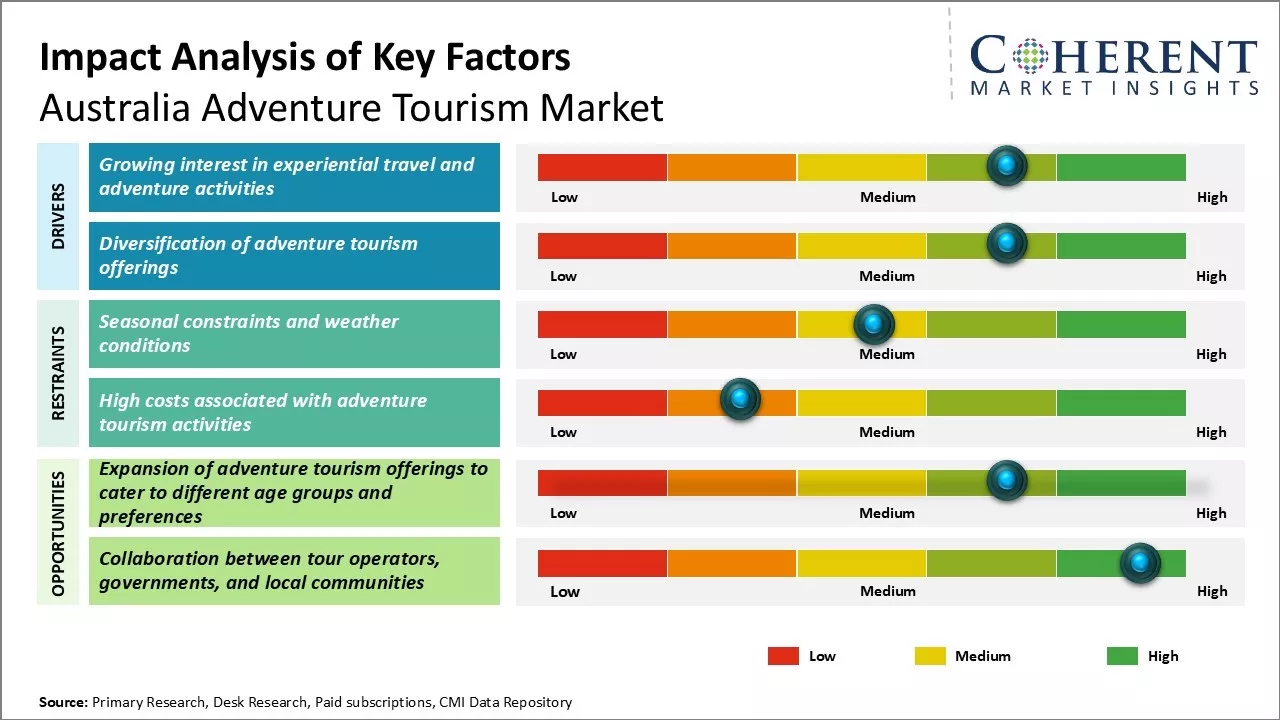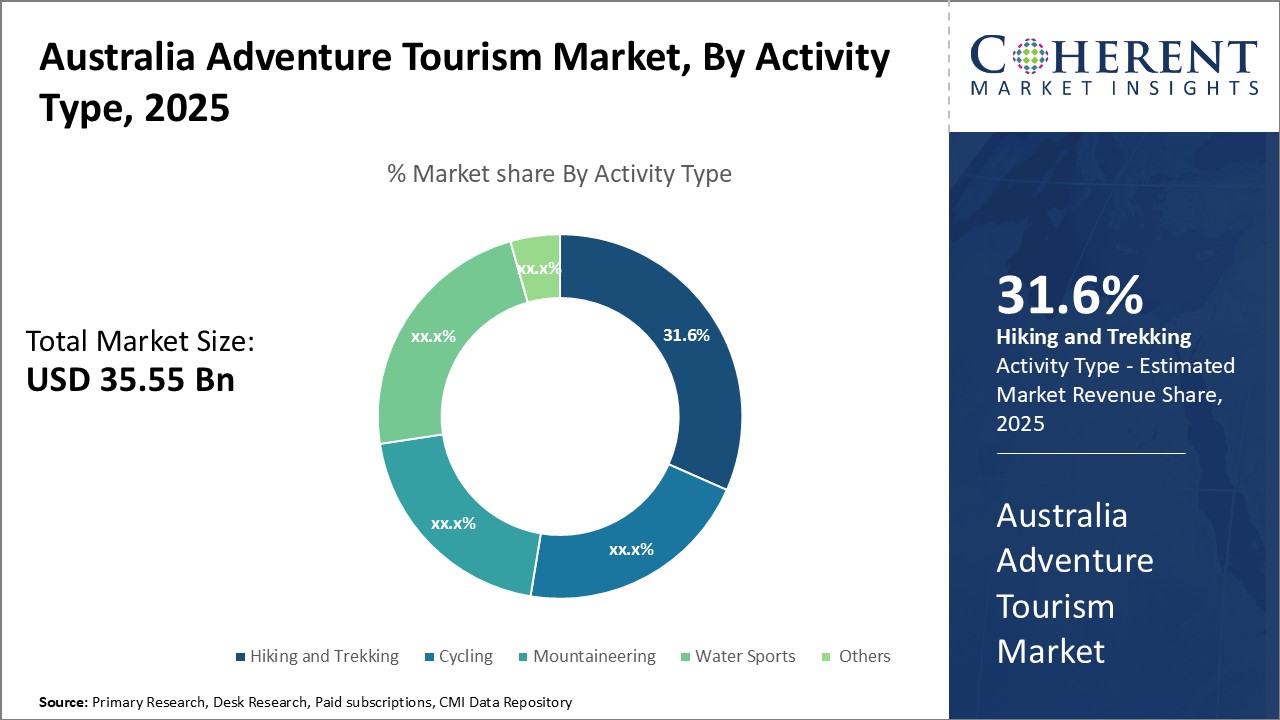Australia Adventure Tourism Market Size and Trends
The Australia adventure tourism market is estimated to be valued at US$ 35.55 billion in 2025 and is expected to reach US$ 116.02 billion by 2032, exhibiting a compound annual growth rate (CAGR) of 18.4% from 2025 to 2032.

Discover market dynamics shaping the industry: Download Free Sample
The market has been witnessing strong growth over the past few years and this trend is anticipated to continue going forward, driven by rising incomes, increasing millennials participation, growing popularity among younger generation for unique experiences, and improving tourism infrastructure in the country.
Market Driver - Growing interest in experiential travel and adventure activities
The tourism landscape of Australia is evolving rapidly driven by changing consumer preferences and interests of modern travelers. There is a notable shift happening where people are moving away from pre-packaged standard tours and resort stays towards seeking out authentic and immersive travel experiences through nature and adventures. The younger demographic especially is fueling this trend as they want to make the most of their trips by living like locals and generating lasting memories through once-in-a-lifetime activities.
Gone are the days when tourism was just about checking places off the list. In today's experience-driven sharing economy, travelers are hungry to feed their sense of adventure through activities like hiking, abseiling, surfing, mountain biking, 4-wheel driving, water sports, and the like. They want challenges that push their limits and stories that can be shared on social media to inspire their friends and followers. The seamless documentation of these experiences further motivates more people to indulge in similar trips. Many are comfortable stepping slightly outside of their comfort zones to encounter breathtaking scenery and wildlife up close through curated adventure tours and packages.
The abundance of natural beauty and outdoor adventures to offer makes Australia an incredibly attractive adventure destination. Its world-class beaches, rainforests, outback, and Great Barrier Reef provide one of the best settings for land and water-based activities. Making the most of this inherent advantage through innovative experiences will continue to attract independent and group travelers seeking activities like swimming with whale sharks, trekking through tropical islands, spotting kangaroos in the wild and more. As lifestyles become more fast-paced, such temporary escapes provide a rejuvenating adrenaline rush and a chance to create lasting memories through unique photo opportunities in impressive outdoor backdrops. This growing interest in experiential travel plays a key role in driving the growth of Australia's adventure tourism industry.
Market Concentration and Competitive Landscape

Get actionable strategies to beat competition: Download Free Sample
Diversification of Adventure Tourism Offerings
Another prominent driver for the Australia adventure tourism market is the diversification taking place in experience offerings. Beyond the standard tours, operators are innovating to cater to varied interests, budgets, seasons and group sizes. Specialized packages tailored to niche interests like wildlife encounters, surf lessons, stargazing, 4WD trips, kayaking, cycling, and others are expanding the appeal further. Short weekend getaways centered on adrenaline pumping or relaxation activities are also gaining popularity for time-strapped travelers or couples.
Regions within Australia too are diversifying their draws beyond the known icons. While the Great Barrier Reef and Kakadu National Park will likely remain top draws for nature and wildlife, other lesser-known spots are introducing new activities to entice visitors. The Outback especially is innovating to appeal beyond just the mundane drive through sparse lands. Experiences like multiday camel treks, searching for ancient rock art, spotting rare bird species and sampling indigenous cuisine immerse travelers more meaningfully in the local culture and history. Coastal towns are promoting water-based adventures from sailing to snorkeling. Even cities are riding the adventure wave through activities like skydiving and indoor rock climbing.
Drawing in niche special interest groups also allows for the better utilization of infrastructure across seasons. Family packages, girls-only trips, photography tours, stargazing cruises, outdoor yoga, and surfing retreats are examples diversifying the client profiles. Multi-day event-based tours during seasonal celebrations like outdoor music festivals and sporting matches further spread visitations beyond holidays. This prevents seasonality issues and low occupancies commonly affecting tourism in regions with extreme climates. With diversification, Australia's adventure tourism industry is better able to sustain growth all year around across experiences, locations and traveler demographics.
Key Takeaways from Analyst:
The Australia adventure tourism market is experiencing robust growth driven by increasing popularity of outdoor activities among both domestic and international tourists. Domestic travelers are the mainstay of this market currently given travel restrictions during the COVID-19 pandemic. The domestic demand has been further bolstered by working professionals taking local trips instead of international vacations.
New South Wales remains the dominant region benefitting from its diverse landscape featuring beaches, outback, and mountains. States like Western Australia and Queensland are witnessing faster growth as they push experiential tourism through new offerings. However, staff shortages in the hospitality industry and high travel costs remain challenges to further tapping the market potential.
Once international borders reopen fully, the international segment is expected to revive quickly considering Australia's allure for nature-based activities. Europe and the North America will likely take the lead in inbound adventure travelers source markets. Tourism boards are intensifying their promotions highlighting untapped destinations to relieve pressure from popular spots and boost regional economies.
Collaborations between activity providers, accommodations, and local communities can help design compelling packages. This will aid consumer convenience and spending across smaller towns. The growth seems poised to accelerate with operators rolling out new experiences and adaptable programs post COVID-19.
Market Challenge - Seasonal constraints and weather conditions
The Australia adventure tourism market faces significant seasonal constraints and uncertainties due to weather conditions. Being an island continent, most of the country experiences hot and dry weather for significant parts of the year, with extreme heat waves common in the summers. Many popular adventure activities such as hiking, camping, watersports, etc., can only be safely undertaken during the milder winter and spring seasons. Heavy rainfall during the summer monsoon further limits the scope for outdoor activities in large geographical regions. Unpredictability of the weather also introduces planning challenges for tourists as well as industry operators. Significant investments are often required to be mothballed for the majority of the year due to inhospitable weather. The seasonal nature of activities impacts the ability to scale businesses and smooth demand over the calendar year. Weather extremes and natural disasters such as bushfires, cyclones or floods also pose safety risks and can suddenly hamper or cancel operations with little notice. This introduces an element of uncertainty for both customers and industry players.
Opportunity: Expansion of adventure tourism offerings to cater to different age groups and preferences
There exists a huge opportunity for the Australia adventure tourism market to expand its offerings in order to cater to the differing needs of varied customer groups. While traditionally the target audience has been the younger backpacker or adventure-seeking demographic, there is a growing market for tailored experiences that can attract older guests or families with children. Operators can develop curated itineraries focused on moderately active experiences such as hiking scenic trails, wildlife viewing or cultural activities suitable for seniors or guests with limited mobility. Water-based activities like snorkeling, kayaking or boat charters can provide interactive options for families with younger kids. Luxury camping experiences glamping and guided safaris enable even non-campers to get a taste of the great outdoors. Catering to new segments will diversify the tourism seasonality challenges and unlock revenue streams from the growing wellness and experiences travel sectors. It can also ensure sustained customer loyalty from an early age if children are engaged in responsible adventure activities shaped by their interests and abilities.

Discover high revenue pocket segments and roadmap to it: Download Free Sample
Insights By Activity Type - Natural Beauty Drives Hiking and Trekking Popularity
In terms of activity type, the hiking and trekking segment is expected to contribute 31.6% share of the market in 2025 owing to Australia's immense natural beauty and variety of trails. Hiking allows people to immerse themselves in nature while taking in scenic vistas. Australia has many national parks like Kakadu, the Blue Mountains, and Wilsons Promontory that offer diverse landscapes like tropical rainforests, deserts, and coastal areas perfect for day hikes or multiday treks. The varied terrain challenges hikers of all abilities and keeps the activity interesting.
Additionally, hiking trails in Australia see cool weather for most of the year making outdoor activities pleasant. Organizations promote hiking by maintaining well-marked trails and producing guidebooks and maps to explore independently or in groups. Word of mouth from travelers experiencing Australia's outdoors boosts hiking's popularity. Many competitive trail races and organizing clubs further drive passions for trekking. The self-reliant nature and physical and mental benefits of hiking appeal to both international visitors and domestic tourists.
Insights By Travel Type - Individual Travel Drives Overall Market Growth
In terms of travel type, individual is expected to contribute 58.9% share of the market in 2025. Australia has a vibrant culture of independent travel and adventurous solo trips. The ability to immerse freely according to one's interests and pace without compromising appeals to many visitors. Self-drive itineraries allow exploring remote areas off the beaten path. Flexibility in accommodations from hostels to camping fits varied budgets. Individual travel opens opportunities to mingle with locals away from packaged tours. Australia's reputation for safety encourages venturing independently. Convenient online resources empower solo planners to craft custom itineraries. The freedom and challenge of traveling alone attracts those seeking transformative experiences.
Insights By Distribution Channel - Online Channels Boost Access to Adventure Options
In terms of distribution channel, the online segment is expected to contribute 63.2% share of the market in 2025. The digital revolution has made researching and booking adventures easier and more convenient. Websites and mobile apps put tour and activity options literally in customers' hands. Online allows comparing features, prices between operators and reading reviews from past travelers. Virtual tours sell destinations and build excitement before visiting. Social media spreads exciting adventure content and real-time experiences globally. Online marketing efficiently reaches target adventure audiences worldwide. The digital experience complements and sometimes replaces traditional in-person planning. As internet access pervades all aspects of life, online channels will continue boosting access to Australia's adventure offerings.
Market Report Scope
Australia Adventure Tourism Market Report Coverage
| Report Coverage | Details | ||
|---|---|---|---|
| Base Year: | 2024 | Market Size in 2025: | USD 35.55 Bn |
| Historical Data for: | 2020 To 2024 | Forecast Period: | 2025 To 2032 |
| Forecast Period 2025 to 2032 CAGR: | 18.4% | 2032 Value Projection: | USD 116.02 Bn |
| Segments covered: |
|
||
| Companies covered: |
AAT Kings Tours Limited, Contiki, Discovery Nomads, G Adventures, Insight Vacations, Inspiring Journeys, Intrepid Group, Ltd, Intro Travel, Ultimate Adventure Travel Pty Ltd, and Trafalgar Travel |
||
| Growth Drivers: |
|
||
| Restraints & Challenges: |
|
||
Uncover macros and micros vetted on 75+ parameters: Get instant access to report
Australia Adventure Tourism Industry News
- In April 2023, Abercrombie & Kent (A&K), a prominent luxury travel company, introduced a new expedition that allows travelers to explore the northernmost point of the Earth. This offering is part of A&K's expanding portfolio of luxury expedition cruises, which include voyages to unique and remote destinations such as Antarctica, the Arctic, and various subarctic islands.
- In December 2022, Active Adventures and Austin Adventures, both specialists in small-group adventure travel, unveiled their revamped brands aimed at enhancing international travel experiences. This brand refresh reflects their commitment to fostering a sense of community among guests while capturing the adventurous spirit and active lifestyle they promote. Active Adventures focuses on exploring breathtaking destinations like Patagonia and New Zealand, while Austin Adventures emphasizes warmth and connection, inspired by the beauty of America's national parks. The new branding includes updated logos, a fresh color palette, and a bespoke typeface, all designed to resonate with their adventurous clientele.
- In April 2021, TUI Group, the world's leading tourism conglomerate, collaborated with Trivago, a prominent global accommodation search platform, to provide Trivago users with direct access to more than 55,000 excursions, activities and tickets. TUI Musement, the Tours & Activities division of TUI Group, powers Trivago's new "Activities" section, offering a diverse portfolio of experiences, from guided tours and tickets for renowned landmarks to unique activities. This partnership aims to meet the anticipated pent-up demand for new experiences as travel resumes, with tours and activities becoming a key element of the customer's overall vacation decision-making process.
*Definition: The Australia adventure tourism market involves tourism activities and services that provide thrilling and exciting experiences for travelers in Australia's unique landscapes and environments. This market caters to individuals who seek adventure while on holiday in Australia through engaging activities like hiking and trekking in various national parks, wildlife spotting tours, scuba diving or snorkeling along the Great Barrier Reef, mountain biking and off-roading through remote Outback areas, surfing at renowned surf breaks, skydiving and bungee jumping at various locations.
Market Segmentation
- Activity Type Insights (Revenue, US$ Bn, 2020 - 2032)
-
- Hiking and Trekking
- Cycling
- Mountaineering
- Water Sports
- Others
- Travel Type Insights (Revenue, US$ Bn, 2020 - 2032)
-
- Individual
- Group
- Distribution Channel Insights (Revenue, US$ Bn, 2020 - 2032)
-
- Online
- Offline
- Key Players Insights
- AAT Kings Tours Limited
- Contiki
- Discovery Nomads
- G Adventures
- Insight Vacations
- Inspiring Journeys
- Intrepid Group, Ltd
- Intro Travel
- Ultimate Adventure Travel Pty Ltd
- Trafalgar Travel
Share
Share
About Author
Ankur Rai is a Research Consultant with over 5 years of experience in handling consulting and syndicated reports across diverse sectors. He manages consulting and market research projects centered on go-to-market strategy, opportunity analysis, competitive landscape, and market size estimation and forecasting. He also advises clients on identifying and targeting absolute opportunities to penetrate untapped markets.
Missing comfort of reading report in your local language? Find your preferred language :
Transform your Strategy with Exclusive Trending Reports :
Frequently Asked Questions
EXISTING CLIENTELE
Joining thousands of companies around the world committed to making the Excellent Business Solutions.
View All Our Clients
